|
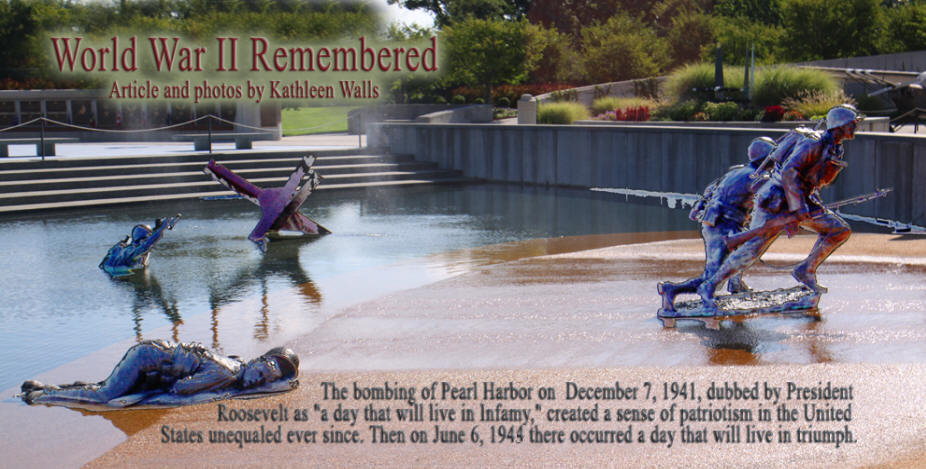
It was on this day, on the beaches of
Normandy that the event occurred that foreshadowed the end of
Hitler's reign of terror and eventually WW ll. Operation
Overlord, the Allies code name for the invasion of France. It
began on the storm torn beaches of Normandy and ended at the
Arch de Triumph with the liberation of Paris.
It didn't come easy or cheap but then
freedom seldom is either easy or cheap.
The year 2015 is the 70th anniversary of
the end of World War II. In commemoration I am giving you a
glimpse of three memorials dedicated to this devastating war.
Each one of these places is unique and well worth a visit in
memory of the over 400 thousand Americans, 12 million other
nations' allied forces and
over three million holocaust victims who died in the most
devastating war of all times.
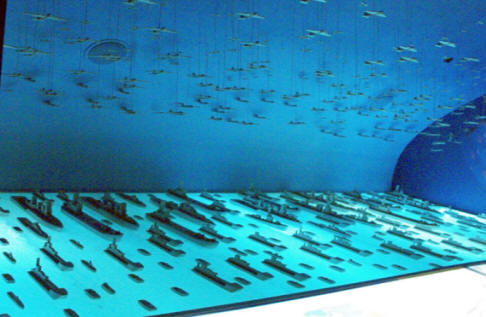 |
| Layout of D Day invasion poised
ot strike |
National World War II in New Orleans ranks number four among
museums in the United States and number 11 in the world
according to Trip Advisor. That's saying a lot. On a recent
visit to the World War II Museum I could see how it achieved its
rank. The museum is huge. The exhibits are real and extensive.
And it's still growing.
For anyone studying the history of World
War II, this place is filled with tons of material, news paper
articles from that time, letters from individuals affected by
the war, documents related to strategy and actual recordings of
soldiers and civilians about their experiences. This museum
transports you back to the war years.
Your trip starts with a train trip from
your home town to the training camp. You hear tapes of real
young men and women explaining their reasons for enlisting. You
will often find WWII veterans volunteering at the museum to tell
their own stories.
Throughout there are many tapes and letters
from real people including General Eisenhower's letter taking
full responsibility for D Day which could so easily have failed.
The personal artifacts are fantastic but two exhibits really
captured my interest. Both reflect on a little known portion of
the war that were pivotal aspects.
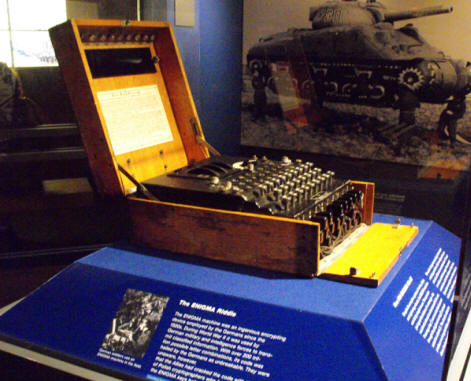 |
| Enigma Machine |
The first was the Enigma Machine. This
was a early precursor to a computer. The Germans developed
Enigma after WW1. It was a complex (for its time) machine that
encrypted information. The Germans believed it uncrackable but
the Poles were able to develop machinery to decipher the code in
December 1932. By 1939, the Germans had improved Enigma to the
degree that the Poles were unable to continue deciphering and
brought in British and French Intelligence personnel and the
newer codes were deciphered. Had the Allies not been able to
crack these codes, the war could have gone differently.
Another of those lesser known exhibits I
found interesting was the contribution of a canny Irishman with
a shipyard located in New Orleans Andrew Jackson Higgins. Hitler
called him "The new Noah."
General Dwight Eisenhower stated, "Andrew Higgins ... is
the man who won the war for us. ... If Higgins had not designed
and built those LCVPs, we never could have landed over an open
beach. The whole strategy of the war would have been different."
Higgins had designed a boat called the
Eureka boat, a shallow-draft craft used by oil well drillers and
fur trappers in the coastal waters of the gulf and Mississippi
River area. These boats could run aground and then back off with
no problem. they were fast and could turn almost within their
own length.
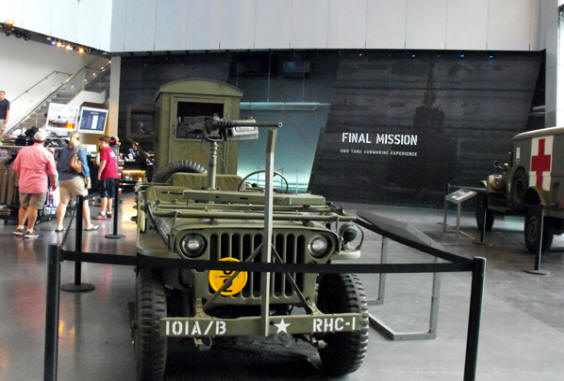 |
| Display of vehicles used in WWII |
The Navy and Marine Corp. became
interested in the Eureka when it appeared their own shipyards
could not provide them with a successful landing craft to deploy
men and equipment on to fortified beaches. The only
drawback to the Eureka was that men had to disembark over the
sides. Higgins developed a better version with a bow ramp which
allowed the men to exit through the front. This new version
became the LCVP (Landing Craft, Vehicle, Personnel), or simply,
the "Higgins Boat."
The museum has a detailed exhibit about
the D Day invasion. It shows all the ships, aircraft and beach
with each section and who would land where.
After you visit the museum itself be sure
to walk to the rear of the lot and view the many types of
transport from tanks to planes used in the war. This is also
where the Tom Hanks movie,
Beyond All Boundaries,
is shown. I didn't get to see it because of time constraints but
I have heard it is excellent.
Take
a moment to view the little Victory Garden between the
main museum and the back section. Victory Gardens were an
important way the people on the home front could contribute to
the war effort.
There is so much more at this museum but
I want to tell you about some other places memorializing WW II
so I'll move on.
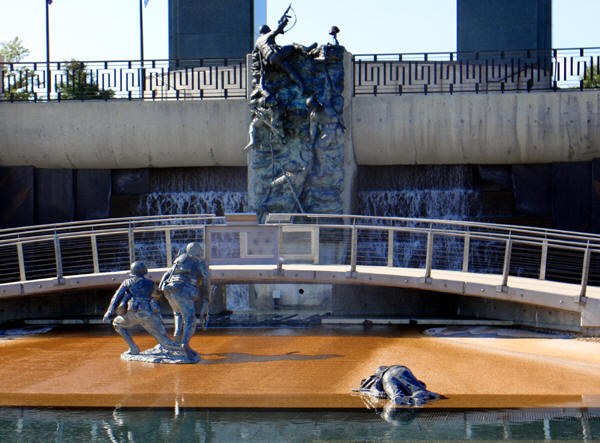 |
| Soldiers scale wall symbolic of
storming the beach at Normandy |
National D-Day Memorial in Bedford, Virginia
is an outdoor
sculpture garden filled with the most poignant figures you can
imagine. According to Trip Adviser, it is the number one
attraction in Virginia.
When I visited, I expected a few statures
set in a nice park. Instead I found an 88 acre park with a
backdrop of the Peaks of Otter
(see more about Peaks of Otter
here) and filled with sculptures in a garden setting that
memorialized one of the most important days in 20th century
history, D Day. In military terminology, D Day merely means the
day on which a combat attack or operation is to be initiated
when the actual day when the actual date has not been set or
where secrecy is important.
Felicia Lowrance, Education Coordinator
for the National D-Day Memorial. explained how the memorial
chronicles the entire spectrum of D Day. She told us to watch
for one of three symbols that we would see repeated throughout
the park; a lion, a dog and a pelican representing valor,
fidelity and sacrifice.
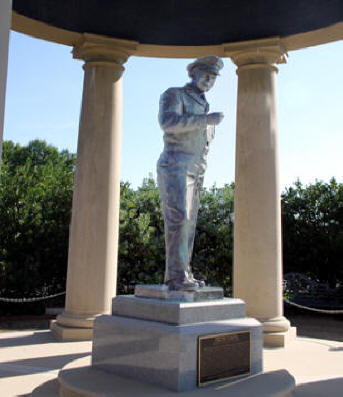 |
| Stature of Eisenhower |
From the moment you step into the garden,
the forty four foot six inch( representing June of 1944)
black and white arch
with OVERLORD emblazoned on it is the centerpiece that tends to
frame all the other sculptures. The pond representing the beach
at Normandy where larger than life bronze sculptures wade
thorough the water
with sprays of water bursting around them representing the
non-ending hail of bullets the soldiers faced as they stormed
Normandy's beaches. On
the edge of the beach, lies a soldier who did not survive the
barrage of bullets and on the beach two soldiers, one carrying a
rifle and looking straight ahead, the other unarmed, a medic,
turned sidewise as if considering ministering to a fallen
comrade. On the wall leading to the top soldiers scale the wall.
No feeling human could look upon this tableau and not be moved.
The larger than life stature of General
Dwight Eisenhower was taken from a famous picture of him
addressing the troops. He seems to be instructing 101st
Airborne in
a last minute address or last bit of information before they go
. In reality, Felicia told us they learned from a visiting
veteran paratrooper who told them "He asked us what sports we
liked. Someone said fly fishing and he started talking to us about
fly fishing."
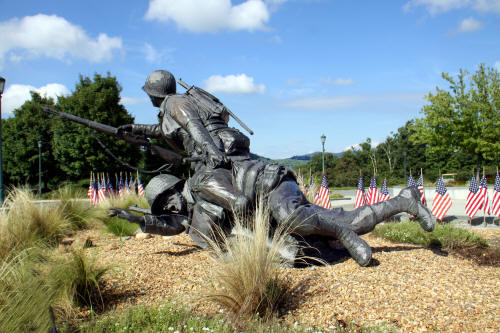 |
| Dragging a wounded comrade to
safety |
Another sculpture that is particularly moving is a copy of
Le Monument aux Morts. the original sculpture stands
outside the Church of St. Aignan at Trevi�res, France. It is a
Nike wearing the
tradition drape but
also a utility belt and helmet of a French soldier of WW1 .
During the fighting after D Day, some shrapnel struck the figure
and blew away a portion of its face below the upper lip along
with most of its throat. This is the stature that is presented
both at the National D Day Memorial and in its original position
in France. It is a
poignant reminder of the devastations of war.
Of course this just scratches the surface of what you will find
at the D Day Memorial.
There is a reason why the memorial is
located in the small town of Bedford. Bedford had the highest
per capita loss of any city in the United States. They lost 19
men from Company A from Bedford within the first thirty minutes
of the attack. This from a community of 3200 people. The
Memorial opened on June 6 3001 with 24,000 people in attendance.
President Bush's
dedication of the Memorial said in part, "The achievement of
Operation Overlord is nearly impossible to overstate, in its
consequences for our own lives and the life of the world. Free
societies in Europe can be traced to the first footprints on the
first beach on June 6, 1944. What was lost on D-Day we can never
measure and never forget."
This memorial will always keep that
memory fresh.
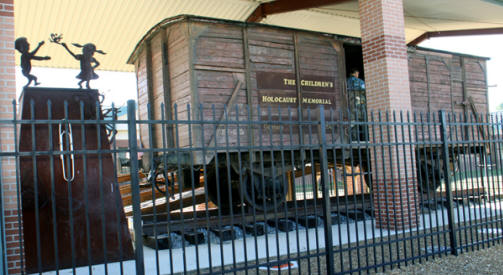 |
| Authentic railcar at the
Holocaust Memorial |
Children's Holocaust Memorial in Whitwell, Tennessee is
unique not because of the size of the museum. It is small and
has less artifacts than many other museums. What makes it stand
out is the way it came to be. We
spoke with Ms. Linda Hooper who was Whitwell Middle School
principal in 1998. She
had asked Assistant Principal David Smith and Sandra Roberts to
head a project to teach tolerance because as she explained,
"This valley is 99% Protestant, white Anglo-Saxon. There is one
Catholic mission and no Jewish families. So that summer there
was a conference to find something to study to make children
realize that there are lots of other people out there and they
are all important and that we need to work to make things
better."
This led to a voluntary afterschool
Holocaust education program. When the children had problems
visualizing the 6,000,000 Jews who died in the Holocaust,
they asked if they could
use some material object as a visual aid. Ms. Hooper said, "It
has to relate to the Holocaust or WW II."
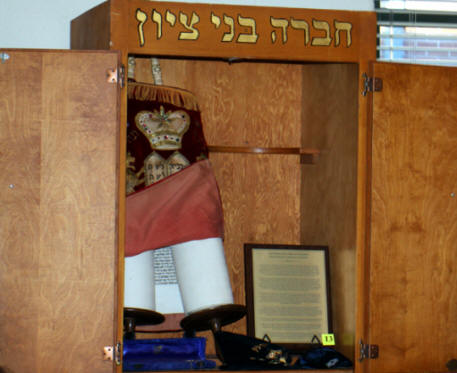 |
| Prized Torah at Holocaust
Memorial |
After some research, the students came up
with the idea of paperclips. You might wonder how that would be
relevant. The paperclip was originally invented by a Norwegian
Jew. During World War II the Norwegians wore paper clips on
their lapels as a protest of the Nazi occupation. So they sent
out appeals to send paper clips with the idea of getting
6,000,000.
They stopped counting at 30,000,000 paper
clips. Many are packed in the railcar, 11,000,000 are in the
children 's monument, some have been sent to a Baptist school in
NJ trying to start a similar project. The rest packed in sheitel
boxes, originally used to hold wigs or half-wigs used by
married, Jewish women to cover their hair, for the little towns
in Poland that were obliterated by the Nazis and put a paperclip
for each person murdered in that town and send them out to the
schools all over. The paper clips are still coming in.
For a memorial with such a humble
beginning, it has some amazing artifacts. For one, it has the
largest collection of Holocaust literature donated to the
memorial by Dr. Benjamin Nachman.
Ms Hooper is particularly proud of their
beautiful hand-written
Torah. She told of
its route into the Memorial, "Our Torah was written in
Pusalotas, Lithuania. traveled
to Johannesburg, South
Africa then to Toronto, Canada where it was driven here
by the family who had originally had
commissioned it. It's over 100 years old and everything
is original except the fringe at the top."
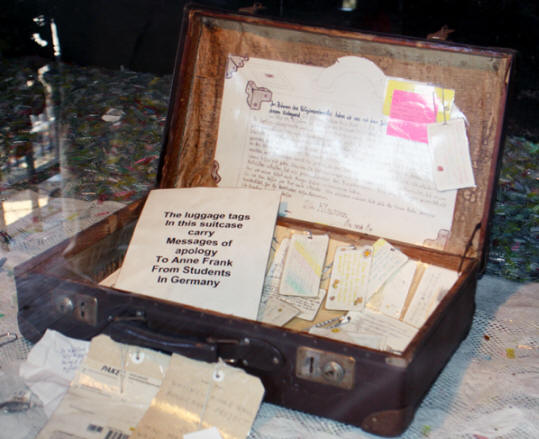 |
| Suitcase from German
schoolchildren filled with apologies |
Ms. Hooper explained about another
amazing article in the memorial, Martin Small's tree, " It has
86 paper clips representing the 86 members of his family and his
wife's family who were murdered during the Holocaust. He made it
for his wife on their 50th anniversary when he was in his 80s."
Martin himself is a Holocaust survivor.
When the camp was liberated in the spring of 1945 by American
forces, Martin had been left for dead in the barracks of the
concentration camp in Gusen. Although he was just a young man in
his twenties. he looked like an ancient
skeleton and weighed only 75 pounds. A American soldier
found him and loaded him into an Army ambulance
which took him along
with other survivors to a hospital in Linz.
But the room inside the school is only
part of the project. Out front of the school is a railcar
surrounded by 18 butterfly sculptures and a monument to the
children of the Holocaust. The
rail car is a authentic transport car used to deliver Jews to
the labor and death camps.
Besides the paper clips it is filled with
memorabilia related to the holocaust such a suitcase filled with
apologies from German students to Anne Frank, letters from
relatives of victims and pictures of victims
I spoke to an eleventh grade student, a
young man named Dalton Slatton . He had been working with the
project for four years. I asked how it has affected his life. He
replied, "I plan to major in Pharmaceuticals and minor in
Political Science. I want to be in a position where if something
like the Holocaust started again I would be in a position to
stop it."
This memorial shows the power of one
idea. I hope this article will inspire each one of you who reads
it to go visit these worthwhile places that recount a poignant
part of our collective history. They represent the best of all
those that gave some and some who gave all that freedom might
live on forever.
For
more info:
http://www.nationalww2museum.org/
http://www.dday.org/
http://images.pcmac.org/SiSFiles/Schools/TN/MarionCounty/WhitwellMid/Uploads/Forms/brochure.pdf
|